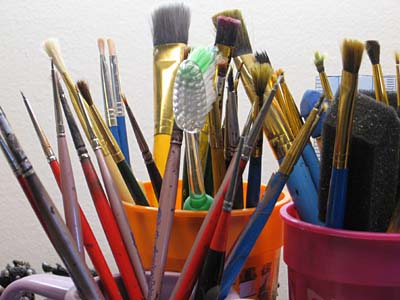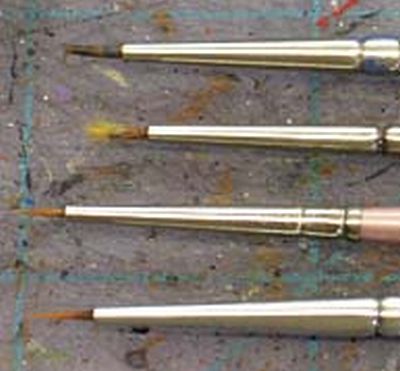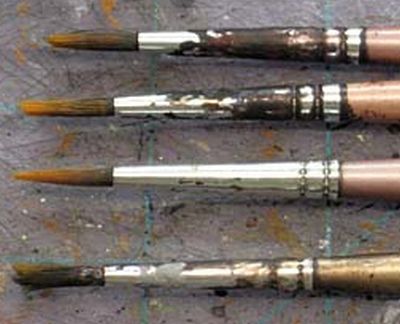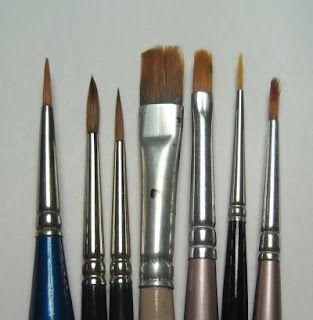
This is a Guest Post by misterjustin
This is the second of a two part follow-up to Ron's post, "All about (my) brushes," with tips on brush care and cleaning.
In part one of this follow-up I covered the anatomy of a brush and some things to look for when selecting a brush. In this article I'm going to cover the care and cleaning of both natural and synthetic brushes and look at some basics tips for brush usage.

This image was taken from Ron's original article and enlarged so you can see the bristles and ferrule more clearly. He described these brushes as his "medium work" brushes and they are 3/0, 3/0, 10/0 and "Precise Detail" respectively. Now I'm going to pick on Ron a bit by drawing your attention to some signs of improper use and care.
In the top brush you can see a grey ring that starts about 1/2 way down the bristles. You'll also notice a slight bend to the brush and a splayed tip. The second brush has a very yellow tip and on the third you can see some old yellow paint near the ferrule. On all three of these you can also spot signs of old paint on the ferrule. The last actually seems to be in fairly good shape.
We'll come back to why I'm picking on these brushes but first I want to look at another set.

This image was also taken from Ron's original article and enlarged so you can get a look at the bristles and ferrule. Ron described these as his "big work" brushes... and they're a mess. You can easily see old, dried paint on the ferrule and in the bristles.

By contrast, this image shows a sample of my own brushes, both natural and synthetic, in similar sizes and from some of the same brands. From left-to-right: The first is a Loew-Cornell synthetic #2 and I've been using it for at least a year. The next two are my Raphael 8404 #1 and #0 respectively, each a little over two months old and both shown here dry. The other four are a random grab from my brush cup and each is at least six months old; all of them are synthetic.
Proper cleaning makes all of the difference. So let me make this point exceptionally clear, on a line of its own:
It is almost impossible to remove dried acrylic paint from natural or synthetic bristles.
There are products out there that will help soften the dried acrylic paint in your bristles but, in the end, the damage has been done.
Tip #1: Never, ever let paint dry on your brush!
This is where the importance of thinning your paints and having a decent reservoir are really highlighted.
If you're painting straight from the pot you can achieve some thinning by simply dipping the brush in water between applications. Dip the brush in water; dip into the paint up to no more than 1/2 of the bristles (or run one side of the bristles against the lid or palette); dab excess water off on a paper towel; apply to model; repeat.
If you're using a palette and thinning your paints to a more watery or milky consistency then you can simply rinse the brush every few applications.
Tip #2: Never use hot water!
The bristles are held into the ferrule, and the ferrule to the handle, with the use of glue. Hot water will weaken that glue and can loosen the bristles. Cold water is better for your brushes although lukewarm can be used for particularly messy clean-up.
Tip #3: Use some soap, ya dirty hippy!
If you use soap only use brush. Dish soap, washing up liquid, hand soap and the like will strip natural oils from hairs and can leave residue on synthetics. However, and this gets its own line too:
USE BRUSH SOAP SPARINGLY
You don't need to soap your brushes every day if you're caring for them properly. Every 2-3 uses is generally adequate.
Tip #4: Natural brushes want natural turpenoid!
Using alcohol will dry natural hair brushes and damage their unique water wicking properties. A quick dip into natural turpenoid will help clean your brushes AND condition the hairs. Do this after every 2-3 soap cleanings.
Tip #5: Use a cleaning pot!
Although not essential to brush care a brush cleaning pot, designed with 2-3 chambers, or multiple cups will further extend the life of your brushes. Using a single cup means that you're cleaning your brush in water that contains progressively more paint. It's like washing dishes in yesterday's bath water. Using multiple chambers or cups means that the additional rinses are done in cleaner water.
Regardless of whether you're rinsing multiple times or in one cup make sure you're using plenty of water. The more water in the cup the longer it takes to saturate with paint.
I picked up my 3 chamber pot at Michaels in the USA for $1.99.
In Summary
By taking proper care of your brushes, whether they're natural or synthetic, you can extend the life on them. This will save you money AND improve the quality of your painting since you won't be working with damaged brushes.
And last but not least, a quick video with some tips on how to use both natural and synthetic brushes to extend their life, whether you're painting directly from the pot or using a palette.
A huge thanks to misterjustin for taking the time to put this together. I appreciate his willingness to share his hobby knowledge with the rest of us painters. - Ron
NEXT: Finally, someone took pity on me and sent me a "good" brush to use.
